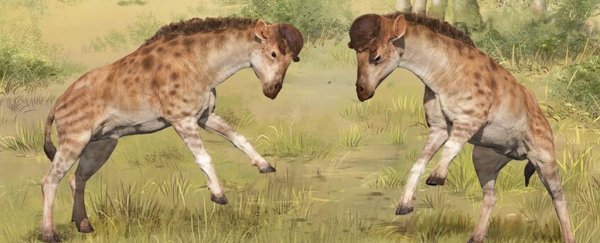In light of the brutal tug-of-war over resources that is natural selection, it's been taken for granted that the giraffe's iconic neck evolved to reach leaves other plant-eaters can't possibly access.
What seemed obvious to Charles Darwin has since attracted a great deal of scrutiny, with some biologists proposing those extended vertebrae aren't for browsing, but rather male weapons of war in the battle for love.
Not all researchers are convinced, leaving plenty of room for debate over the benefit of the giraffe's cartoonish morphology.
A study based on the skull and vertebrae of an ancient herbivore now adds fresh evidence to the discussion, concluding at least one giraffe-like grazer did indeed have necks built for bashing.
The fossilized bones were uncovered in northern China more than 20 years ago by paleontologist Jin Meng, today a curator at the American Museum of Natural History in New York City.
A fresh analysis of the discovery by Meng and his colleagues has revealed characteristics of the mammal that might help us to better understand the forces involved in the development of the giraffe's unique anatomy.
Named after a mythical unicorn-goat in Chinese lore, the newly described Discokeryx xiezhi was determined to be an ancient member of the Giraffoidea superfamily that roamed the Miocene savannah some 17 million years ago.
What stands out most about D. xiezhi isn't gracile proportions, but rather a stocky build capped in a skull reminiscent of a medieval foot-soldier's helmet. Flat, wide, and slightly brimmed, it's the kind of headgear perfect for weathering a clash or two with a rival.
To test their hypothesis that D. xiezhi's skull provided advantages in physical conflict, the team of researchers used a mathematical technique for measuring the potential forces the skull and vertebrae could withstand under various collisions.
They found the specific structure of the bones and their joints was capable of withstanding some extraordinary violence, perhaps more so than any other known head-butting animal.
Though only distantly related to modern giraffes, the discovery implies head-to-head combat wouldn't be a novel behavior for this branch of the animal kingdom.
"Both living giraffes and Discokeryx xiezhi belong to the Giraffoidea, a superfamily," says the study's first author, Chinese Academy of Sciences paleontologist Wang Shi-Qi.
"Although their skull and neck morphologies differ greatly, both are associated with male courtship struggles and both have evolved in an extreme direction."
A comparison of the structures and shapes of skull protrusions and horns of ancient ruminating mammals – including other giraffoids, sheep, and pronghorn – suggests relatives to the giraffe evolved a wider variety of headgear, building a case for combat as a major factor in the evolution of the giraffe's cranium and vertebrae.
The habitat D. xiezhi found itself in also closely resembled the open grasslands modern giraffes evolved to suit, further hinting at shared behaviors.
"Stable isotopes of tooth enamel have indicated that Discokeryx xiezhi was living in open grasslands and may have migrated seasonally," says Meng.
There's no easy way to demonstrate with certainty the kinds of pressures at work nudging and shaping an organism's features.
More importantly, natural selection isn't discriminating when it comes to purpose. If a long neck helps fight, feed, and flee predators without compromising too much on fitness, then it's going to stick around a little longer.
But knowing there's a few butt-heads in the family might help persuade a few more biologists that a long neck might be a handy tool in the fight for survival.
This research was published in Science.
